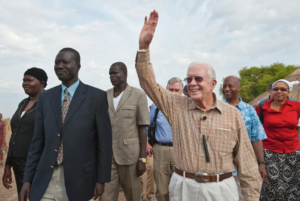First published May 13, 2025 by The Carter Center
The prospect of eradicating Guinea worm disease remains on track, with just 15 human cases reported in two countries in 2024.
That figure compares with some of the lowest annual totals of human cases ever reported. When The Carter Center assumed leadership of the global Guinea Worm Eradication Program in 1986, an estimated 3.5 million human cases occurred annually in 21 countries in Africa and Asia.

Since 1986, the success of the campaign has averted more than 100 million cases of the devastating parasitic disease.
Nine of the 15 cases reported in 2024 occurred in Chad, and six were in South Sudan. A small number of additional 2024 specimens that may or may not be Guinea worms were awaiting laboratory evaluation at press time. All figures for the disease were officially confirmed at the eradication campaign’s global annual meeting, which took place in Chad in April.
“A single worm can cause multiple new cases the following year, and we’re actively preventing outbreaks in some of the most challenging and complex environments,” said Dr. Kashef Ijaz, Carter Center vice president of health programs.
In the six countries where Guinea worm remains under surveillance — Angola, Cameroon, Chad, Ethiopia, Mali, and South Sudan — reported infections in animals declined 25%, from 887 in 2023 to 664 in 2024. Chad reduced animal infections by 43% (from 496 to 281), its fifth consecutive year of improvement. Reductions in animal infections in Chad, Angola, and Mali were partially offset by an increase in Cameroon. The same species of worm, Dracunculus medinensis, infects both humans and animals, so eradication requires eliminating it in both.
“The low numbers show that communities’ commitment to reaching zero and interventions to reduce human suffering are working, said Adam Weiss, director of the Carter Center’s Guinea Worm Eradication Program.
Guinea worm is poised to become the second human disease in history to be eradicated, following smallpox. It also would be the first parasitic disease to be eradicated and the first done without use of a medicine or vaccine. Local mobilization and community-based behavioral change are the formula for success.
The Carter Center leads the global eradication campaign, working closely with national ministries of health and a variety of global institutions including the World Health Organization, the U.S. Centers for Disease Control and Prevention, UNICEF, and other partners.
Read more about the this successful program from UNICEF: With Guinea Worm Eradication in Sight, a Celebration of a Humanitarian Legacy
WHO Dracunculiasis (Guinea-worm disease) fact sheet
Watch this video from The Carter Center:
Related Articles

Eradicating Guinea Worm Disease: A Story of Hope, Partnership, and Persistence
A new documentary chronicles President Jimmy Carter’s nearly four-decade campaign to eliminate guinea worm disease—an ancient parasite that once afflicted millions—using education and clean water rather than vaccines or medication.

Jimmy Carter Took on the Awful Guinea Worm When No One Else Would — And Triumphed
The effort to end Guinea worm disease relies almost entirely on changes in people’s behavior. There is no cure, no vaccination. When the 39th president of the United States left office, Jimmy Carter campaigned to eradicate the disease.

The Unstoppable Makoy Samuel Yibi and the Quest to Eradicate Guinea Worm
Makoy Samuel Yibi’s relentless efforts have brought Guinea worm disease to the brink of eradication. With support from the Carter Center, Makoy traverses rugged terrain in South Sudan to contain outbreaks and prevent future infections.
